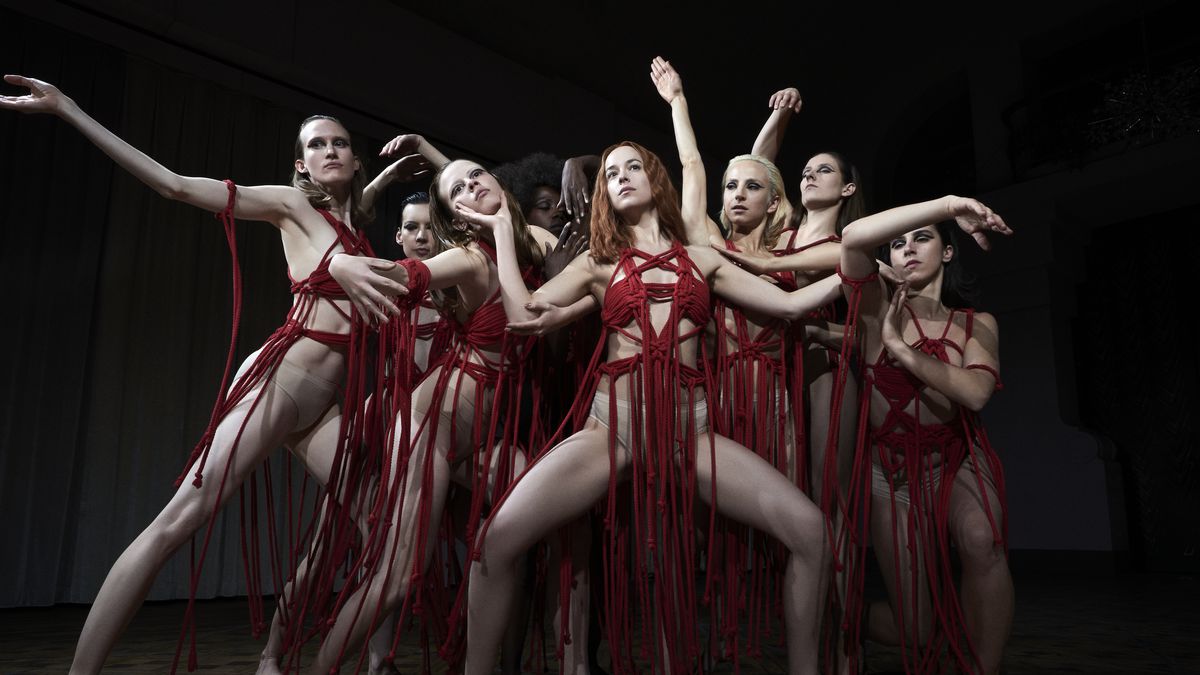Bold is the person who attempts a remake of a classic horror film as distinctive as Dario Argento’s Suspiria. The classic 1977 horror movie about a German dance school for girls doubling as a coven of witches has the Italian filmmaker’s definitive fingerprints all over it. So, why did director Luca Guadagnino (I Am Love, Call Me by Your Name) remake it when he is such an original filmmaker in his own right? Granted, both directors share a penchant for big emotions and stunning settings, but for such a unique artist as Guadagnino, it feels like a tangent and a self-indulgent one at that.
Especially odd is that so much of the what Guadagnino does her feels far too derivative of Argento. The cocked camera angles, the abrupt edits, the insinuating score – this feels less like a reimagining than a riff. Granted, the modern production values of the newer version give it more of a Grade A gloss, and the cast is certainly more star-driven, but most of it feels all too familiar. Casting Dakota Johnson as the lead gives this one novelty, and it’s nice to see her stretch way beyond those E.L. James adaptations, but the most unique part of this film is the casting of Guadagnino favorite Tilda Swinton in three different roles. The Oscar-winning actress is terrific in all three performances, but ultimately the repetition feels too gimmicky, particularly as she essays the male lead.

Dakota Johnson
It’s one thing for Mike Myers or Peter Sellers to play multiple roles in a comedy, but when the film is a thriller, such self-consciousness prohibits an enveloping sense of dread. Instead, it makes this feel like a movie about moviemaking, with the film continually stepping outside itself each moment Swinton’s onscreen. Swinton’s rendering of the geezer she’s playing, assisted by some of the best makeup this side of Gary Oldman in “Darkest Hour,” continually verges on kitsch. And what is the point of it, to give Swinton more to do, to show off? Do either her or Guadagnino need to revel in such indulgent tricks?
As Dr. Josef Klemperer, he/she dominates most of the story and has the largest character arc too. The good doctor is a local psychiatrist in West Berlin, circa 1977, and he’s got one troubled patient in ballet student Patricia (Chloe Grace Moretz). She’s one of the standouts at the nearby Helena Markos Dance Company, but the school and its teachers are driving her batty. She tells Klemperer wild tales about her teachers forcing her into satanic rituals and exhibiting a desire to consume her flesh. He listens dutifully, but key plot points start to become eclipsed by Swinton’s excesses in her performance. Even the notes her character scribbles become less about the words and more about how fantastic the makeup is on her hands in close-up.
It doesn’t help that the female lead of Suzie Bastian (Johnson) is underdeveloped. The gamine American dance student comes to Europe from her farming community in the Midwest full of “fish out of water” neurosis. Soon, the girl’s naïveté starts fading and her intuitive talent takes over. During an audition for the lead part in a school show, her herky-jerky interpretative dance moves seem to be full of evil. Not only does she look demonic and otherworldly, but her gestures seem to be literally breaking the bones of a rival in a practice room on another floor. Is Suzie aware of her moves destroying her competitor’s body? Or is the evil part of something bigger and more demonic? Such questions about the foundations of evil are great to explore, but the film’s violent excesses go well beyond what is required to make the point.
Perhaps Guadagnino is trying to underline the messages in David Kajganich’s screenplay about sin, power, and sisterhood, but as the bone-crunching and twisting torture drags on and on, the film starts to veer from arthouse to grindhouse. And as the film continues on, length issues become more and more a detriment. Dance numbers repeat moves we’ve already seen a number of times, searches through the secret passageways take too long, etc. Horror doesn’t have to clock in under two hours, but sustaining fright becomes more problematic as a film goes on. Argento took only 98 minutes to tell his tale, but Guadagnino takes over two hours and 30 minutes.

Tilda Swinton
The strengths of Guadagnino’s film lie mostly in the production design. Every scene seems framed for unease and malevolence. Right from the get-go, the secret passageways and dark corridors render the school as more haunted house. And the insidious and insinuating score is the kind that causes nails to dig into the arms of theater seats. The climax is a set-piece of audacious cinema as Klemperer finds out the whole truth of what’s going on in the school, in a ritual sacrifice room full of blood, nudity, female empowerment, and hellzapoppin violence.
Yet, despite the fantastical, nightmare images, this remake ultimately seems to be more of an exercise in filmmaking than storytelling. Look no further than the visual of Swinton writhing around in that climax as a naked hag of a witch waiting to be reborn. The old lady fat suit she’s wearing is a marvel of construction, such a grotesque creation that it rivals Ivan Albright’s painting of Dorian Gray, yet the stunt of it overwhelms the scene. Guadagnino continually cuts back to her, over and over again, as if to poke us and implore, “See, isn’t that an amazing feat of makeup?”
It truly is, but like the rest of his film, it’s too self-conscious and far too padded.
View the trailer of Suspiria below:

